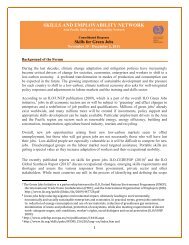FACTORS AFFECTING THE PERFORMANCE OF WOMEN ENTREPRENEURS IN MICRO ...
FACTORS AFFECTING THE PERFORMANCE OF WOMEN ENTREPRENEURS IN MICRO ...
FACTORS AFFECTING THE PERFORMANCE OF WOMEN ENTREPRENEURS IN MICRO ...
You also want an ePaper? Increase the reach of your titles
YUMPU automatically turns print PDFs into web optimized ePapers that Google loves.
CHAPTER TWO<br />
REVIEW <strong>OF</strong> RELATED LITERATURE<br />
This chapter revises the different literatures written in the areas of entrepreneurship,<br />
women entrepreneurs; women entrepreneurs in MSEs; the problems of entrepreneurship;<br />
factors affecting the performance of women entrepreneurs in MSEs; and the supports<br />
given by TVET to MSEs.<br />
2.1 An overview to entrepreneurship<br />
As globalization reshapes the international economic landscape and technological change<br />
creates greater uncertainty in the world economy, the dynamism of entrepreneurship is<br />
believed to be able to help to meet the new economic, social and environmental<br />
challenges. Governments increasingly consider entrepreneurship and innovation to be the<br />
cornerstones of a competitive national economy, and in most countries entrepreneurship<br />
policies are in fact closely connected to innovation policies, with which they share many<br />
characteristics and challenges. The dynamic process of new firm creation introduces and<br />
disperses innovative products, processes and organizational structures throughout the<br />
economy. Entrepreneurship objectives and policies nevertheless differ considerably<br />
among countries, owing to different policy needs and diverse perspectives on what is<br />
meant by entrepreneurship. In support of this Schumpeter (2005) stated,<br />
In some countries, entrepreneurship is linked to regional development programs and<br />
the creation of new firms is stimulated to boost employment and output in depressed<br />
regions. In others, entrepreneurship is a key element of strategies designed to<br />
facilitate the participation of certain target groups, such as women or minorities, in<br />
the economy. Some countries simply seek to increase firm creation as such, while<br />
others set out to support high-growth firms. While many countries are making serious<br />
efforts to support entrepreneurship, results appear to vary. Countries want to<br />
understand the determinants of and obstacles to entrepreneurship, and they need to<br />
analyze the effectiveness of different policy approaches (p.13)<br />
The lack of internationally comparable empirical evidence has however constrained our<br />
understanding of entrepreneurship and many questions remain unanswered. Ultimately,<br />
policy making must be guided, as far as possible, by evidence and facts.<br />
8
















